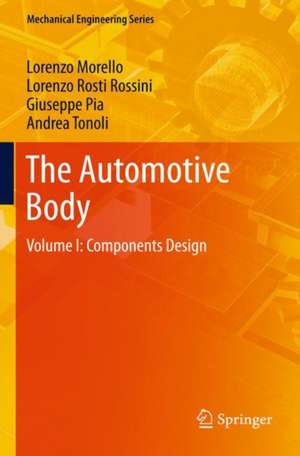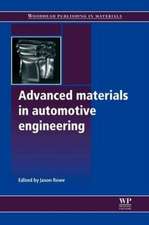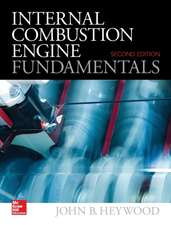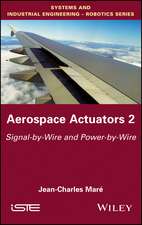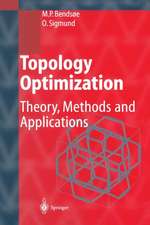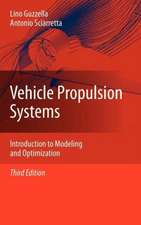The Automotive Body: Volume I: Components Design: Mechanical Engineering Series
Autor L. Morello, Lorenzo Rosti Rossini, Giuseppe Pia, Andrea Tonolien Limba Engleză Hardback – 23 dec 2010
The first volume produces the needful cultural background on the body; it describes the body and its components in use on most kinds of cars and industrial vehicles: the quantity of drawings that are presented allows the reader to familiarize with the design features and to understand functions, design motivations and fabrication feasibility, in view of the existing production processes.
The second volume addresses the body system engineer and has the objective to lead him to the specification definition used to finalize detail design and production by the car manufacturer or the supply chain. The processing of these specifications, made by mathematical models of different complexity, starts always from the presentations of the needs of the customer using the vehicle and from the large number of rules imposed by laws and customs.
The two volumes are completed by references, list ofsymbols adopted and subjects index.
These two books about the vehicle body may be added to those about the chassis and are part of a series sponsored by ATA (the Italian automotive engineers association) on the subject of automotive engineering; they follow the first book, published in 2005 in Italian only, about automotive transmission.
They cover automotive engineering from every aspect and are the result of a five-year collaboration between the Polytechnical University of Turin and the University of Naples on automotive engineering.
| Toate formatele și edițiile | Preț | Express |
|---|---|---|
| Paperback (2) | 597.85 lei 6-8 săpt. | |
| SPRINGER NETHERLANDS – 15 oct 2014 | 597.85 lei 6-8 săpt. | |
| SPRINGER NETHERLANDS – 27 ian 2013 | 664.91 lei 38-44 zile | |
| Hardback (2) | 660.49 lei 6-8 săpt. | |
| SPRINGER NETHERLANDS – 27 dec 2010 | 660.49 lei 6-8 săpt. | |
| SPRINGER NETHERLANDS – 23 dec 2010 | 752.10 lei 6-8 săpt. |
Din seria Mechanical Engineering Series
-
 Preț: 391.84 lei
Preț: 391.84 lei - 18%
 Preț: 1110.72 lei
Preț: 1110.72 lei - 15%
 Preț: 593.73 lei
Preț: 593.73 lei - 18%
 Preț: 944.99 lei
Preț: 944.99 lei - 15%
 Preț: 653.14 lei
Preț: 653.14 lei - 17%
 Preț: 363.13 lei
Preț: 363.13 lei - 18%
 Preț: 1239.05 lei
Preț: 1239.05 lei - 15%
 Preț: 640.06 lei
Preț: 640.06 lei - 18%
 Preț: 1129.65 lei
Preț: 1129.65 lei - 15%
 Preț: 522.24 lei
Preț: 522.24 lei - 15%
 Preț: 654.77 lei
Preț: 654.77 lei - 15%
 Preț: 643.34 lei
Preț: 643.34 lei - 15%
 Preț: 611.40 lei
Preț: 611.40 lei - 18%
 Preț: 765.96 lei
Preț: 765.96 lei - 20%
 Preț: 631.71 lei
Preț: 631.71 lei - 18%
 Preț: 1009.22 lei
Preț: 1009.22 lei -
 Preț: 418.34 lei
Preț: 418.34 lei - 15%
 Preț: 640.71 lei
Preț: 640.71 lei -
 Preț: 403.53 lei
Preț: 403.53 lei - 18%
 Preț: 813.97 lei
Preț: 813.97 lei - 18%
 Preț: 1386.48 lei
Preț: 1386.48 lei - 18%
 Preț: 951.47 lei
Preț: 951.47 lei - 18%
 Preț: 833.09 lei
Preț: 833.09 lei - 18%
 Preț: 936.60 lei
Preț: 936.60 lei - 15%
 Preț: 644.49 lei
Preț: 644.49 lei - 18%
 Preț: 941.05 lei
Preț: 941.05 lei - 18%
 Preț: 1386.17 lei
Preț: 1386.17 lei -
 Preț: 399.67 lei
Preț: 399.67 lei - 18%
 Preț: 1389.44 lei
Preț: 1389.44 lei - 18%
 Preț: 790.46 lei
Preț: 790.46 lei - 18%
 Preț: 1388.22 lei
Preț: 1388.22 lei - 18%
 Preț: 1024.53 lei
Preț: 1024.53 lei - 15%
 Preț: 590.16 lei
Preț: 590.16 lei - 18%
 Preț: 1234.00 lei
Preț: 1234.00 lei - 18%
 Preț: 1386.62 lei
Preț: 1386.62 lei - 15%
 Preț: 543.85 lei
Preț: 543.85 lei -
 Preț: 391.61 lei
Preț: 391.61 lei - 18%
 Preț: 944.19 lei
Preț: 944.19 lei - 18%
 Preț: 736.16 lei
Preț: 736.16 lei - 18%
 Preț: 943.88 lei
Preț: 943.88 lei - 15%
 Preț: 693.21 lei
Preț: 693.21 lei - 18%
 Preț: 781.77 lei
Preț: 781.77 lei - 15%
 Preț: 639.08 lei
Preț: 639.08 lei - 23%
 Preț: 737.29 lei
Preț: 737.29 lei - 15%
 Preț: 641.53 lei
Preț: 641.53 lei -
 Preț: 401.42 lei
Preț: 401.42 lei
Preț: 752.10 lei
Preț vechi: 917.21 lei
-18% Nou
Puncte Express: 1128
Preț estimativ în valută:
143.93€ • 149.71$ • 118.82£
143.93€ • 149.71$ • 118.82£
Carte tipărită la comandă
Livrare economică 14-28 aprilie
Preluare comenzi: 021 569.72.76
Specificații
ISBN-13: 9789400705128
ISBN-10: 9400705123
Pagini: 692
Ilustrații: XXII, 668 p.
Dimensiuni: 155 x 235 x 50 mm
Greutate: 1.15 kg
Ediția:2011
Editura: SPRINGER NETHERLANDS
Colecția Springer
Seria Mechanical Engineering Series
Locul publicării:Dordrecht, Netherlands
ISBN-10: 9400705123
Pagini: 692
Ilustrații: XXII, 668 p.
Dimensiuni: 155 x 235 x 50 mm
Greutate: 1.15 kg
Ediția:2011
Editura: SPRINGER NETHERLANDS
Colecția Springer
Seria Mechanical Engineering Series
Locul publicării:Dordrecht, Netherlands
Public țintă
ResearchCuprins
Contents; About the authors; Foreword; Preface; Acknowledgements; 1 Introduction to Volume I; 2 Historical Evolution; 2.1 Industrial organization; 2.2 Non unitized bodies and chassis; 2.3 Partially unitized bodies and chassis; 2.4 Unitized bodies and chassis; 2.5 Body shape evolution; 2.6 Electric components; 3 Graphic Representation Systems; 3.1 Introduction; 3.2 CAS, computer aided styling; 3.3 CAD, computer aided design; 3.4 DMU, digital mock-up; 4 Body Work; 4.1 Body in White; 4.2 Body Side; 4.3 Fenders; 4.4 Roof assembly; 4.5 Front frame; 4.6 Rear frame; 4.7 Compartment floor; 4.8 Closed bodies;4.9 Spider, Coupe and Cabrio; 4.10 Commercial vehicles and trucks; 5 Body Components; 5.1 Outer body components; 5.2 Weather strips; 5.3 Glass and mirrors; 5.4 Movable parts; 5.5 Windshield wiper; 5.6 Vehicle lighting and signalling; 6 Body Interiors; 6.1 Restraint systems — safety belts; 6.2 Restraint system -- air-bag; 6.3 Dashboard cockpit - dashboard - console; 6.4 Interior trims; 6.5 Seats; 6.6 Air conditioning system; References; Index.
Notă biografică
Lorenzo Morello received his degree in Mechanical Automotive Engineering in 1968 at the Politecnico of Turin. He immediately began his career at the Politecnico as Assistant of Machine Design and Technologies.
Leaving the Politecnico in 1971, went to work at a branch of Fiat dedicated to vehicle studies, one that has been joined to the new Research Centre in 1976. He participates in the development of cars and experimental prototypes for the ESV US Program. He has also developed mathematical models for vehicle suspensions and road holding simulations.
Since 1973 he has been involved in a major project for the development of mathematical modeIs of the vehicle, to address the product policies of the company in facing the first energy crisis; as part of this activity he began the development of a new automatic transmission for reduced fuel consumption and a small direct injection diesel engine to be used on automobiles.
Dr. Morello was appointed manager of the chassisdepartment of the Vehicle Research Unit and has coordinated the development of many research prototypes, such as electric cars, off-road vehicles, trucks and buses. He was appointed manager of the same Research Unit in 1977 and has been leading a group of about 100 design engineers, dedicated to the development of prototypes. A new urban bus with unitized thin steel sheet body, with spot welded joints, a commercial vehicle that will start production later, a small lightweight urban car, under contract from the National Research Council, and a hybrid car, under contract from the US Department of Energy, were developed in this period of time.
He took responsibility of the Engine Research Unit in 1980; this group, of about 200 people, was primarily dedicated to the development of new car engines. He has managed the development of many petrol engines according to the principle of high turbulence fast combustion. A direct injection diesel engine for cars, many turbocharged pre-chamber diesel engines, a modular two cylinder car engine and many other modified prototypes. He was appointed Director of Product Development in 1983; this position includes all applied research activities on Vehicle Products of Fiat Group. The Division included about 400 people, addressed to power train, chassis and bodies studies as well as prototype construction.
Dr. Morello joined Fiat Auto in 1983, to take responsibility for the development of new automotive petrol engines and the direct injection diesel (the first in the world for automobile applications). He was appointed Director for Powertrain Engineering in 1987; the objective of this group was to develop all engines produced by Fiat Auto brands. The most important activity in this period was the development of the new engine family to be produced in Pratola Serra, which included more than 20 different engines.
At the end of his career, he returned to vehicle development in 1994, as director for Vehicle Engineering; this group was addressed to designing and testing bodies, chassis components, electric and electronic systems, wind tunnels, safety center and other facilities.
Dr. Morello retired in 1999 and started a new activity as consultant to the strategic planning of Elasis, a new company in the Fiat Group, entirely dedicated to vehicle applied research.
Along with Fiat Research Center he participated in the planning of courses for the new Faculty on Automotive Engineering of the Politecnico of Turin, and prepared related lecture notes. He was contract professor of Vehicle System Design and has been contract professor of Automotive Transmission Design since 2001 at the Politecnico of Turin and the University of Naples.
Relevant publications
Progetto della trasmissione meccanica (Automotive Transmission Design), Levrotto e Bella, Torino 2005.
With Giancarlo Genta, The Automotive Chassis, to be published by Springer.
6 Articles published by Ingegneria dell'Autoveicolo, Magazine of the Italian Automotive Engineers Association, between 2006 and 2008, about automotive product evolution.
4 Articles published by Autotecnica, Italian magazine for automotive engineers, between 2007 and 2008, about car suspensions design.
Leaving the Politecnico in 1971, went to work at a branch of Fiat dedicated to vehicle studies, one that has been joined to the new Research Centre in 1976. He participates in the development of cars and experimental prototypes for the ESV US Program. He has also developed mathematical models for vehicle suspensions and road holding simulations.
Since 1973 he has been involved in a major project for the development of mathematical modeIs of the vehicle, to address the product policies of the company in facing the first energy crisis; as part of this activity he began the development of a new automatic transmission for reduced fuel consumption and a small direct injection diesel engine to be used on automobiles.
Dr. Morello was appointed manager of the chassisdepartment of the Vehicle Research Unit and has coordinated the development of many research prototypes, such as electric cars, off-road vehicles, trucks and buses. He was appointed manager of the same Research Unit in 1977 and has been leading a group of about 100 design engineers, dedicated to the development of prototypes. A new urban bus with unitized thin steel sheet body, with spot welded joints, a commercial vehicle that will start production later, a small lightweight urban car, under contract from the National Research Council, and a hybrid car, under contract from the US Department of Energy, were developed in this period of time.
He took responsibility of the Engine Research Unit in 1980; this group, of about 200 people, was primarily dedicated to the development of new car engines. He has managed the development of many petrol engines according to the principle of high turbulence fast combustion. A direct injection diesel engine for cars, many turbocharged pre-chamber diesel engines, a modular two cylinder car engine and many other modified prototypes. He was appointed Director of Product Development in 1983; this position includes all applied research activities on Vehicle Products of Fiat Group. The Division included about 400 people, addressed to power train, chassis and bodies studies as well as prototype construction.
Dr. Morello joined Fiat Auto in 1983, to take responsibility for the development of new automotive petrol engines and the direct injection diesel (the first in the world for automobile applications). He was appointed Director for Powertrain Engineering in 1987; the objective of this group was to develop all engines produced by Fiat Auto brands. The most important activity in this period was the development of the new engine family to be produced in Pratola Serra, which included more than 20 different engines.
At the end of his career, he returned to vehicle development in 1994, as director for Vehicle Engineering; this group was addressed to designing and testing bodies, chassis components, electric and electronic systems, wind tunnels, safety center and other facilities.
Dr. Morello retired in 1999 and started a new activity as consultant to the strategic planning of Elasis, a new company in the Fiat Group, entirely dedicated to vehicle applied research.
Along with Fiat Research Center he participated in the planning of courses for the new Faculty on Automotive Engineering of the Politecnico of Turin, and prepared related lecture notes. He was contract professor of Vehicle System Design and has been contract professor of Automotive Transmission Design since 2001 at the Politecnico of Turin and the University of Naples.
Relevant publications
Progetto della trasmissione meccanica (Automotive Transmission Design), Levrotto e Bella, Torino 2005.
With Giancarlo Genta, The Automotive Chassis, to be published by Springer.
6 Articles published by Ingegneria dell'Autoveicolo, Magazine of the Italian Automotive Engineers Association, between 2006 and 2008, about automotive product evolution.
4 Articles published by Autotecnica, Italian magazine for automotive engineers, between 2007 and 2008, about car suspensions design.
Textul de pe ultima copertă
“The Automotive Body” consists of two volumes.
The first volume produces the needful cultural background on the body; it describes the body and its components in use on most kinds of cars and industrial vehicles: the quantity of drawings that are presented allows the reader to familiarize with the design features and to understand functions, design motivations and fabrication feasibility, in view of the existing production processes.
The second volume addresses the body system engineer and has the objective to lead him to the specification definition used to finalize detail design and production by the car manufacturer or the supply chain. The processing of these specifications, made by mathematical models of different complexity, starts always from the presentations of the needs of the customer using the vehicle and from the large number of rules imposed by laws and customs.
The two volumes are completed by references, list ofsymbols adopted and subjects index.
These two books about the vehicle body may be added to those about the chassis and are part of a series sponsored by ATA (the Italian automotive engineers association) on the subject of automotive engineering; they follow the first book, published in 2005 in Italian only, about automotive transmission.
They cover automotive engineering from every aspect and are the result of a five-year collaboration between the Polytechnical University of Turin and the University of Naples on automotive engineering.
The first volume produces the needful cultural background on the body; it describes the body and its components in use on most kinds of cars and industrial vehicles: the quantity of drawings that are presented allows the reader to familiarize with the design features and to understand functions, design motivations and fabrication feasibility, in view of the existing production processes.
The second volume addresses the body system engineer and has the objective to lead him to the specification definition used to finalize detail design and production by the car manufacturer or the supply chain. The processing of these specifications, made by mathematical models of different complexity, starts always from the presentations of the needs of the customer using the vehicle and from the large number of rules imposed by laws and customs.
The two volumes are completed by references, list ofsymbols adopted and subjects index.
These two books about the vehicle body may be added to those about the chassis and are part of a series sponsored by ATA (the Italian automotive engineers association) on the subject of automotive engineering; they follow the first book, published in 2005 in Italian only, about automotive transmission.
They cover automotive engineering from every aspect and are the result of a five-year collaboration between the Polytechnical University of Turin and the University of Naples on automotive engineering.
Caracteristici
A complete and updated overview on existing design architecture; A systematic approach explaining how to link design specifications to customer's needs and components design to design specifications; Material selected from design praxis and put together to support courses on automotive engineering.
